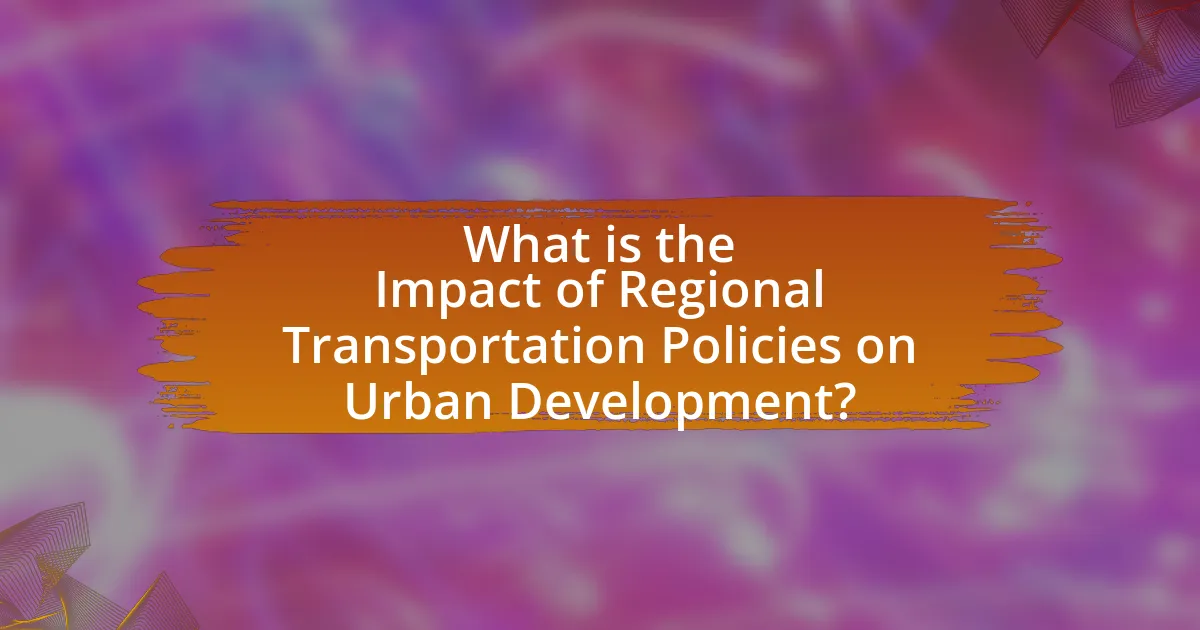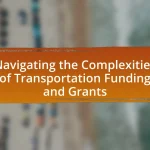Regional transportation policies play a crucial role in shaping urban development by influencing land use patterns, accessibility, and economic growth. These policies determine infrastructure investments in public transit, roads, and bike lanes, which directly impact how cities expand and how residents interact with their environment. Key components include infrastructure planning, funding mechanisms, regulatory frameworks, and stakeholder engagement, all of which interact with urban planning to enhance connectivity and sustainability. The article explores the implications of transportation policies on urban infrastructure, land use, public services, and the challenges urban planners face in integrating these policies for effective urban development. Additionally, it highlights best practices and lessons learned from successful case studies to maximize the benefits of transportation policies.

What is the Impact of Regional Transportation Policies on Urban Development?
Regional transportation policies significantly influence urban development by shaping land use patterns, accessibility, and economic growth. These policies determine the infrastructure investments in public transit, roads, and bike lanes, which directly affect how cities expand and how residents interact with their environment. For instance, cities that prioritize public transportation often see higher density development along transit corridors, leading to reduced reliance on cars and promoting sustainable urban growth. Research from the American Planning Association indicates that regions with robust public transit systems experience a 20% increase in property values near transit stations, demonstrating the economic benefits of such policies. Additionally, effective transportation policies can mitigate traffic congestion and improve air quality, further enhancing urban livability.
How do regional transportation policies influence urban growth?
Regional transportation policies significantly influence urban growth by shaping accessibility and connectivity within metropolitan areas. These policies determine the development of infrastructure such as roads, public transit systems, and bike lanes, which directly affect the movement of people and goods. For instance, cities that invest in efficient public transportation tend to experience higher population densities and economic activity in areas served by transit lines, as evidenced by studies showing that regions with robust transit systems see a 20-30% increase in property values near transit stations. Additionally, transportation policies that prioritize sustainable modes of transport can lead to more compact urban development, reducing urban sprawl and promoting mixed-use neighborhoods. This correlation between transportation infrastructure and urban growth is supported by historical data, such as the expansion of cities like Portland, Oregon, which implemented policies favoring public transit and walkability, resulting in significant urban revitalization and growth.
What are the key components of regional transportation policies?
The key components of regional transportation policies include infrastructure planning, funding mechanisms, regulatory frameworks, and stakeholder engagement. Infrastructure planning focuses on the development and maintenance of transportation networks, ensuring connectivity and accessibility. Funding mechanisms determine how transportation projects are financed, often involving public-private partnerships and government allocations. Regulatory frameworks establish the legal guidelines for transportation operations and safety standards. Stakeholder engagement involves collaboration with community members, businesses, and government entities to align transportation initiatives with regional needs and priorities. These components collectively influence urban development by shaping mobility patterns, economic growth, and land use.
How do these components interact with urban planning?
Regional transportation policies significantly influence urban planning by shaping land use, accessibility, and infrastructure development. These policies determine the allocation of resources for transportation projects, which in turn affects urban density and the distribution of services. For instance, investments in public transit systems can lead to higher density development around transit hubs, promoting mixed-use neighborhoods and reducing reliance on automobiles. Studies have shown that cities with robust public transportation options experience increased economic activity and improved quality of life, as seen in cities like Portland, Oregon, where transit-oriented development has been linked to sustainable urban growth. Thus, the interaction between regional transportation policies and urban planning is crucial for fostering efficient, sustainable urban environments.
What role do transportation policies play in shaping urban infrastructure?
Transportation policies are crucial in shaping urban infrastructure by determining the allocation of resources, guiding land use, and influencing transportation modes. These policies establish frameworks for investment in roads, public transit, and pedestrian pathways, which directly affect urban design and accessibility. For instance, cities that prioritize public transportation through policies often see increased density around transit hubs, leading to more efficient land use and reduced traffic congestion. Research from the American Planning Association indicates that effective transportation policies can lead to a 20% reduction in vehicle miles traveled, promoting sustainable urban growth and enhancing the quality of life for residents.
How do transportation investments affect urban land use?
Transportation investments significantly influence urban land use by shaping accessibility and connectivity within cities. Improved transportation infrastructure, such as roads, public transit systems, and bike lanes, often leads to increased land values and encourages higher-density development in areas with better access. For instance, studies have shown that properties located near transit stations can experience value increases of 10% to 30%, as seen in cities like San Francisco and Washington, D.C. This shift in land use patterns promotes mixed-use developments, reduces urban sprawl, and can lead to more sustainable urban environments. Additionally, transportation investments can redirect growth towards underdeveloped areas, fostering economic opportunities and revitalizing neighborhoods.
What are the implications for public services and amenities?
The implications for public services and amenities are significant, as regional transportation policies directly influence accessibility and resource allocation. Improved transportation infrastructure enhances access to essential services such as healthcare, education, and public safety, thereby increasing their utilization. For instance, studies show that cities with efficient public transit systems experience a 20% increase in access to healthcare facilities, leading to better health outcomes. Additionally, well-planned transportation policies can stimulate economic growth, resulting in increased funding for public amenities, such as parks and recreational facilities, which further enrich community life.
Why is understanding the impact of transportation policies essential for urban planners?
Understanding the impact of transportation policies is essential for urban planners because these policies directly influence urban development, land use, and community accessibility. Effective transportation policies can enhance connectivity, reduce congestion, and promote sustainable growth, while poorly designed policies can lead to urban sprawl, increased traffic, and environmental degradation. For instance, research from the Transportation Research Board indicates that cities with integrated transportation planning experience 20% less traffic congestion compared to those without such policies. This demonstrates that urban planners must analyze transportation policies to create efficient, livable urban environments.
What challenges do urban planners face in integrating transportation policies?
Urban planners face significant challenges in integrating transportation policies, primarily due to conflicting stakeholder interests, budget constraints, and the complexity of urban environments. Conflicting interests arise from various stakeholders, including government agencies, private developers, and community groups, each with different priorities and goals. Budget constraints limit the ability to implement comprehensive transportation solutions, often forcing planners to prioritize short-term fixes over long-term strategies. Additionally, the complexity of urban environments, characterized by existing infrastructure, land use patterns, and demographic diversity, complicates the integration of transportation policies, making it difficult to create cohesive and effective plans. These challenges are documented in studies such as the “Transportation Research Board’s Special Report 288,” which highlights the need for collaborative approaches and innovative funding mechanisms to address these issues effectively.
How can planners leverage transportation policies for sustainable development?
Planners can leverage transportation policies for sustainable development by integrating multimodal transport systems that prioritize public transit, cycling, and walking. This approach reduces reliance on single-occupancy vehicles, thereby decreasing greenhouse gas emissions and traffic congestion. For instance, cities that have implemented comprehensive public transit networks, such as Curitiba in Brazil, have seen significant reductions in carbon emissions and improved urban mobility. Additionally, policies that promote mixed-use development near transit hubs encourage higher density living, which can lead to more efficient land use and reduced urban sprawl. Evidence from the American Public Transportation Association indicates that public transit use can reduce individual carbon footprints by up to 45%.
What are the key trends in regional transportation policies affecting urban development?
Key trends in regional transportation policies affecting urban development include increased investment in public transit systems, a focus on sustainable transportation options, and the integration of technology in transportation planning. Public transit investments, such as those seen in cities like Los Angeles and New York, aim to reduce traffic congestion and promote accessibility, which directly influences urban density and land use patterns. Sustainable transportation policies prioritize walking, cycling, and electric vehicles, as evidenced by initiatives in cities like Amsterdam and Copenhagen, which have led to reduced carbon emissions and improved urban livability. Additionally, the integration of smart technologies, such as real-time data analytics and autonomous vehicles, is reshaping transportation infrastructure and urban planning, as seen in cities like Singapore and San Francisco, enhancing efficiency and connectivity in urban environments.
How are emerging technologies influencing transportation policy decisions?
Emerging technologies are significantly influencing transportation policy decisions by enabling data-driven approaches and enhancing operational efficiency. For instance, the integration of artificial intelligence and big data analytics allows policymakers to analyze traffic patterns and optimize public transit routes, leading to more effective resource allocation. Additionally, the rise of electric and autonomous vehicles is prompting regulations that promote sustainable practices and safety standards, as seen in California’s policies aimed at reducing greenhouse gas emissions and encouraging electric vehicle adoption. These technological advancements are reshaping the framework within which transportation policies are developed, ensuring they are more responsive to current urban mobility challenges.
What are the implications of climate change on transportation planning?
Climate change significantly impacts transportation planning by necessitating the integration of climate resilience and sustainability into infrastructure development. Transportation planners must consider increased flooding, extreme weather events, and rising sea levels, which can damage existing infrastructure and disrupt services. For example, the National Oceanic and Atmospheric Administration (NOAA) reports that sea levels along the U.S. coast have risen by an average of 8 inches since 1880, leading to increased vulnerability of coastal transportation networks. Additionally, planners are required to adopt low-emission technologies and promote public transit to reduce greenhouse gas emissions, as transportation accounts for approximately 29% of total U.S. greenhouse gas emissions according to the Environmental Protection Agency (EPA). This shift towards sustainable practices is essential for mitigating climate change effects and ensuring the long-term viability of transportation systems.
How can cities effectively implement transportation policies to enhance urban development?
Cities can effectively implement transportation policies to enhance urban development by integrating multimodal transportation systems that prioritize accessibility and sustainability. This approach encourages the use of public transit, cycling, and walking, which can reduce traffic congestion and lower greenhouse gas emissions. For instance, cities like Copenhagen have successfully increased cycling infrastructure, resulting in a 62% increase in bike usage from 2006 to 2016, demonstrating the positive impact of such policies on urban mobility and development. Additionally, implementing policies that promote mixed-use developments near transit hubs can stimulate economic growth and improve community connectivity, as seen in cities like Portland, where transit-oriented development has led to increased property values and local business growth.
What best practices exist for aligning transportation and urban development goals?
Best practices for aligning transportation and urban development goals include integrated planning, stakeholder engagement, and sustainable design principles. Integrated planning ensures that transportation infrastructure is developed in conjunction with urban growth strategies, allowing for efficient land use and mobility. Stakeholder engagement involves collaboration among government agencies, community members, and private sectors to create a shared vision and address diverse needs. Sustainable design principles promote environmentally friendly practices, such as mixed-use developments and public transit accessibility, which enhance urban livability and reduce reliance on personal vehicles. These practices are supported by studies indicating that cities employing integrated transportation and land-use planning experience improved economic outcomes and reduced traffic congestion.
How can stakeholder engagement improve policy outcomes?
Stakeholder engagement can improve policy outcomes by ensuring that diverse perspectives and expertise are incorporated into the decision-making process. This inclusion leads to more informed policies that address the actual needs and concerns of the community, resulting in higher acceptance and compliance. For example, research by the International Association for Public Participation indicates that projects with stakeholder involvement are 30% more likely to succeed, as they reflect the interests of those affected. Engaging stakeholders also fosters collaboration, which can lead to innovative solutions and more effective implementation of policies, particularly in complex areas like regional transportation that directly impact urban development.
What are the common pitfalls in regional transportation policy implementation?
Common pitfalls in regional transportation policy implementation include inadequate stakeholder engagement, insufficient funding, and lack of data-driven decision-making. Inadequate stakeholder engagement often leads to policies that do not reflect the needs of the community, resulting in public resistance and ineffective solutions. Insufficient funding can hinder the execution of planned projects, causing delays and incomplete infrastructure. Lack of data-driven decision-making can result in policies based on assumptions rather than empirical evidence, leading to inefficient resource allocation and poor outcomes. These pitfalls have been documented in various studies, such as the “Transportation Policy and Urban Development” report by the Transportation Research Board, which highlights the importance of comprehensive planning and community involvement in successful policy implementation.
How can cities avoid the negative impacts of poorly designed transportation policies?
Cities can avoid the negative impacts of poorly designed transportation policies by implementing comprehensive planning that prioritizes multimodal transportation options. This approach encourages the integration of public transit, cycling, and pedestrian pathways, which can reduce congestion and improve accessibility. For instance, cities like Copenhagen have successfully reduced car dependency by investing in extensive cycling infrastructure, resulting in a 62% decrease in carbon emissions from transportation since 1995. Additionally, engaging community stakeholders in the planning process ensures that transportation policies meet the needs of diverse populations, thereby enhancing public support and effectiveness.
What lessons can be learned from successful case studies?
Successful case studies in regional transportation policies reveal that integrated planning, stakeholder engagement, and data-driven decision-making are crucial for effective urban development. For instance, the case of Portland, Oregon, demonstrates how a comprehensive transportation plan that includes public transit, cycling infrastructure, and pedestrian-friendly designs can lead to increased urban density and reduced traffic congestion. This is supported by the fact that Portland’s investment in light rail and bike lanes has resulted in a 30% increase in public transit ridership since 1990, showcasing the positive impact of cohesive transportation strategies on urban growth.
What practical strategies can urban planners adopt to maximize the benefits of transportation policies?
Urban planners can maximize the benefits of transportation policies by implementing integrated land-use planning, enhancing public transit accessibility, and promoting active transportation options. Integrated land-use planning ensures that transportation infrastructure aligns with residential and commercial development, reducing travel distances and congestion. Enhancing public transit accessibility, such as increasing service frequency and coverage, encourages higher ridership and decreases reliance on personal vehicles. Promoting active transportation options, like walking and cycling, through the development of safe and connected pathways, fosters healthier communities and reduces environmental impact. These strategies are supported by studies indicating that integrated approaches lead to more sustainable urban environments and improved quality of life for residents.


